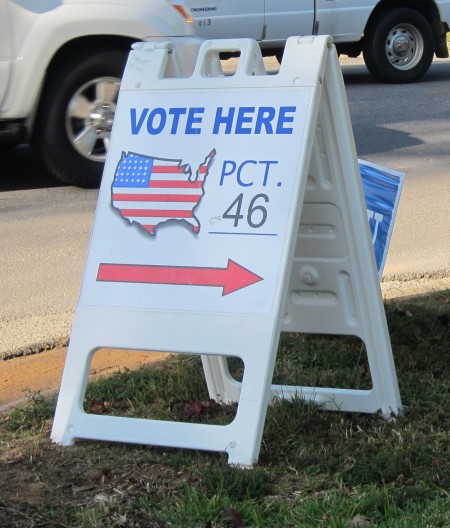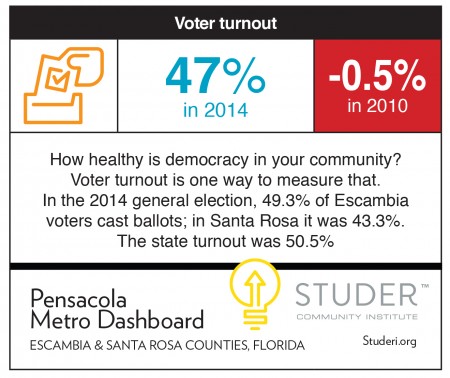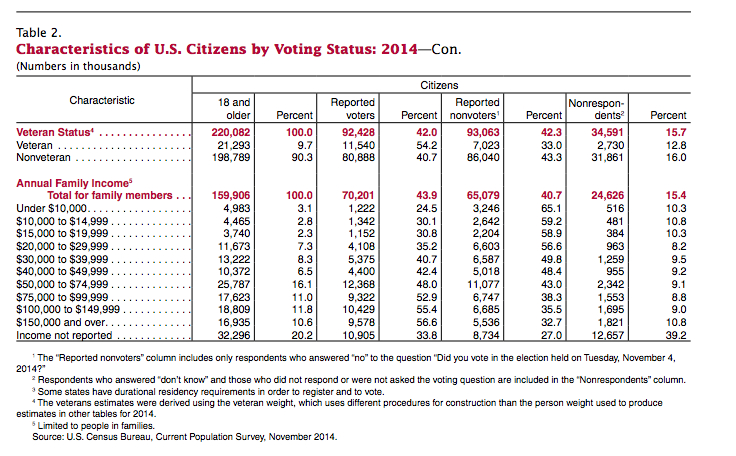You get the government you elect
- September 28, 2015
- / Shannon Nickinson
- / community-dashboard

Democracy is not a spectator sport.
You have to get in it to get the most out of it. For most of us, that means voting.
Voter turnout is an important gauge of how many people feel engaged in their government. That's why it is one of 16 metrics in the Studer Community Institute's Pensacola Metro Dashboard. Created in consultation with the University of West Florida’s Office of Economic Development and Engagement, the dashboard is an at-a-glance look at the social, economic and educational well-being of our community.
In the 2014 election, 49.3 percent of Escambia's registered voters cast ballots; 43.3 percent of Santa Rosa's registered voters did so. The state figure was 50 percent.
In the last presidential election cycle — when turnout is typically higher — 75.5 percent of Escambia registered voters voted; in Santa Rosa it was 66.2 percent, according to the Florida Division of Elections.
While election day 2016 is more than a full calendar year away, the media's election cycle news coverage is in full swing. Amid the breakdowns of the crowded field of candidates for the presidential nominations, you may have missed this little nugget from Vox.com, which looked at how voting patterns by income level impact the kind of policies Congress and other elected leaders then pursue.
Here's a bit of Sean McElwee's story, headlined: "One big reason Congress ignore the poor: they don't vote":
This has a real impact on who we elect. Americans who vote are different from those who don’t. Voters are older, richer, and whiter than nonvoters, in part because Americans lack a constitutional right to vote and the various restrictions on voting tend to disproportionately impact the less privileged. In 2014, turnout among those ages 18 to 24 with family incomes below $30,000 was 13 percent. Turnout among those older than 65 and making more than $150,000 was 73 percent. The result is policy that is biased in favor of the affluent. As I argue in a new report, "Why Voting Matters," higher turnout would transform American politics by giving poor, young, and nonwhite citizens more sway.At the national level, this chart from a July publication by the U.S. Census Bureau compares voters by income level.
Escambia Supervisor of Elections David Stafford says his office doesn't keep turnout record broken down by income. They do track who voted in age, race and gender. For the 2012 election — the last presidential election cycle — there were 198,275 registered voters in Escambia County.
—76 percent of white and black registered voters voted.
— 77 percent of women and 73.5 percent of men voted.
— 66.7 percent of people under 45 voted; 83 percent of people 46 and older voted.
— 85 percent of voters 66 and older voted; 61 percent of voters ages 18-25 voted.

As the Vox article points note attitudes about what the government's role should differ greatly by household income. It's worth a read.
And it's worth considering that even though you may be developing fatigue for the 2016 election cycle already, the most important thing we can do on Election Day is participate.

 CivicCon launches with a look at good growth in cities
CivicCon launches with a look at good growth in cities
 Building stronger brains one baby, one parent at a time
Building stronger brains one baby, one parent at a time
 SCI debuts commercial on Early Learning City
SCI debuts commercial on Early Learning City
 Entrecon: World class speakers and an opportunity to sharpen skills
Entrecon: World class speakers and an opportunity to sharpen skills
 PYP Quality of Life survey 2017
PYP Quality of Life survey 2017
 EntreCon Pensacola 2016: A look back
EntreCon Pensacola 2016: A look back
 Leadership tip: getting better employee takeaways
Leadership tip: getting better employee takeaways
 Leadership tip: be interested instead of interesting
Leadership tip: be interested instead of interesting
 Leadership tip: delivering difficult messages
Leadership tip: delivering difficult messages
 Brain Bags boost Arc, Early Childhood Court programs
Brain Bags boost Arc, Early Childhood Court programs